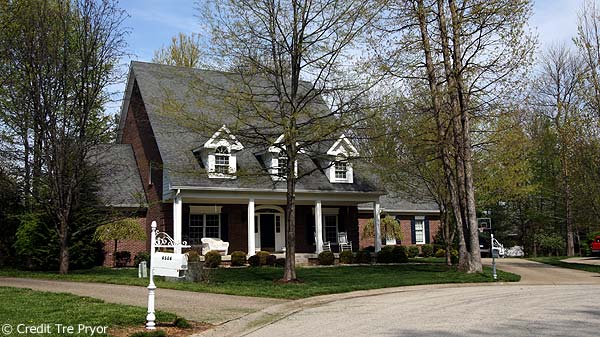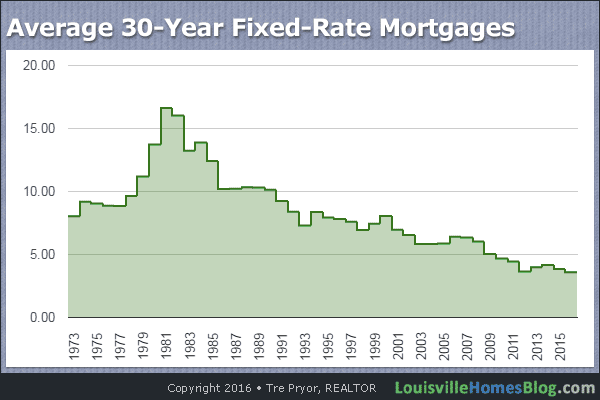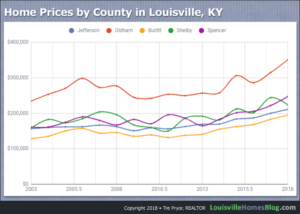Mortgages are highly specialized financial products. The actual interest rate you pay will be based on a number of factors. The following are sure to be part of the picture:

- Location of the property
- Value of the property
- Your financial past (i.e. foreclosures or bankruptcies)
- Size of your down-payment
- Credit score
- Military service
Depending on the lender, they can actually look at other variables as well. After all, they’re taking on a certain amount of risk by loaning you this money for your home purchase.
The primary reason for this post is to see where mortgage rates are now in relation to where they’ve been in the last 50 years. We’ll also take a look at where rates are likely going in 2017.
Before we look at Louisville mortgage rates, we want to get a broader perspective. The only historical mortgage data that is archived is what we find at Freddie Mac. They publish the average monthly rate (with points) on 30-year fixed-rate mortgages going all the way back to 1971.
These are general rates before any of the personal criteria is applied but it gives us a worthwhile look at where we currently are compared to years past. Rather than post the numbers, it’s always better to view things in chart form so here you go!

For the sake of simplicity, I’m not including average points. Of course, you should include these in your calculations as you consult with your loan specialist. The best financial product for your specific situation will need to take into consideration a good number of variables.
Since 2010, we’ve enjoyed historically low-interest rates! I’m wondering if people understand just how good we’ve got it. For example, the difference between a 30-year rate of 4.5% compared to 5.5% allows you to purchase approximately $25,000 more home for the same monthly payment. Nice huh?
Louisville Mortgage Rates
Data for Louisville mortgage rates isn’t as easy to find. I was only able to locate the most recent values for our market.
For the most part, Louisville mortgage rates mirror the National rates, only just a bit lower. Here are the average rates for the months in 2016 according to Trulia.
| 2016 | Louisville | National |
| January | 3.66 | 3.87 |
| February | 3.45 | 3.66 |
| March | 3.54 | 3.69 |
| April | 3.43 | 3.61 |
| May | 3.43 | 3.60 |
| June | 3.40 | 3.57 |
| July | 3.32 | 3.44 |
| August | 3.26 | 3.44 |
| September | 3.28 | 3.46 |
| October | 3.33 | 3.47 |
| November | 3.69 | 3.77 |
Did you read Tre Pryor’s 2016 Louisville Real Estate Year in Review? We had a record-setting year! I’m sure our ultra-low interest rates played a role in this phenomenon.
So, where are rates going now?
Mortgage Rates Going Forward
I’ve been writing about how great low-interest rates are for Louisville home buyers. Here’s one I wrote in 2011 using a Tom and Jerry illustration. The following year I hit on the fact that interest rates were being held low by the Fed for multiple reasons but that it couldn’t do so indefinitely.
The political sides disagree. Yet, sooner or later the Fed has to stop its bond buybacks and allow interest rates to rise naturally. It looks like now that the Democrats are out of office the time could be now. It should be a gradual change to keep panic at a minimum.
What this means for home buyers is that mortgage rates are moving higher in 2017. Not maybe but definitely. As in most things, what’s bad for one group is good for another. In this case, what’s bad for home buyers is good for investors, as higher rates mean better returns.
At this point, it looks like we should expect three-quarter point increases in the new year according to Fed chair Janet Yellen but things could change. With that in mind, by this time next year rates should be around 4.75% or so.
Given the historical chart I presented above, this is still wonderful if you’re in the market to make a move.



